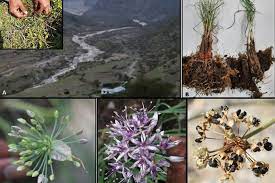20 Oct 2021 Allium Negianum

- Recently, a newly discovered plantAllium negianum, in Uttarakhand has been confirmed to belong to the genus that includes many staple foods such as onion and garlic.
- A staple food makes up the dominant part of a population’s diet.
- They are eaten regularly even daily and supply a major proportion of a person’s energy and nutritional needs.
About:
- Allium is one of the largest genera in Amaryllidaceae.
- Amaryllidaceaeis a family of herbaceous (connected with plants that have soft stems), mainly perennial and bulbous flowering plants.
- The genus Allium contains about 1,100 species worldwide, including many staple foods like onion, garlic, scallion, shallot and chives.
- The genus naturally occurs in dry seasons in the northern hemisphere and South Africa but the newly-identified species is restricted to the region of the western Himalaya.
- The scientific name Allium negianum honours the late Dr. Kuldeep Singh Negi, an eminent explorer and Allium collector from India.
- They are useful for various medicinal purposes.
Distribution in India:
- The Indian Allium is distributed in different eco-geographical areas of the temperate and alpine regions of Himalayas.
- The Indian Himalayan region has two distinct centers of Allium diversity, the Western Himalaya (over 85% of total diversity)and the Eastern Himalaya (6%), covering the alpine-sub temperate region.
Condition of Growth:
- It grows at 3,000 to 4,800 m above sea level and can be found along open grassy meadows, sandy soils along rivers, and streams forming in snow pasture lands along alpine meadows.
Threat:
- Indiscriminate harvesting of its leaves and bulbs for seasoning may pose a threat to its wild populations.
yojna ias daily current affairs 20 Oct 2021


No Comments